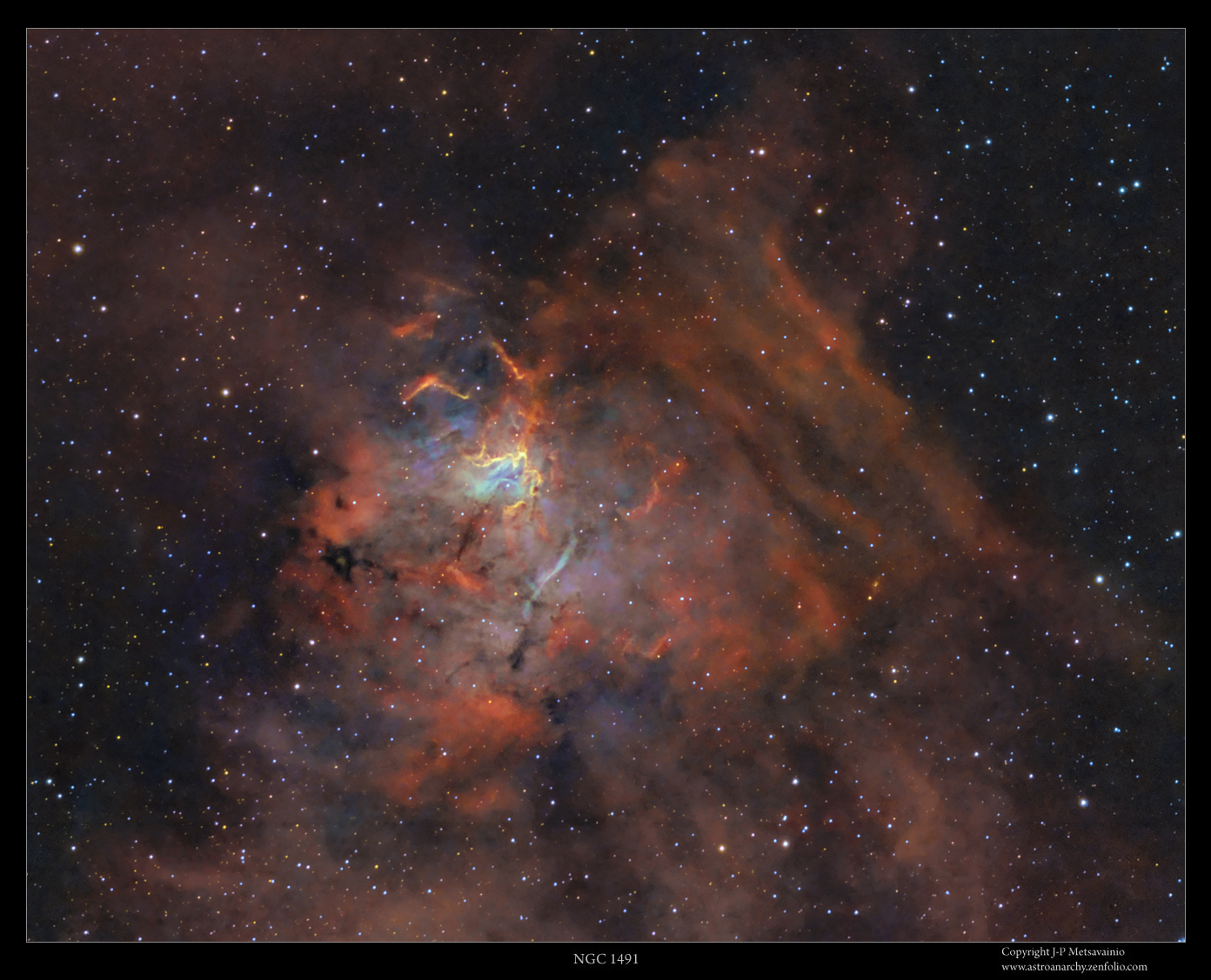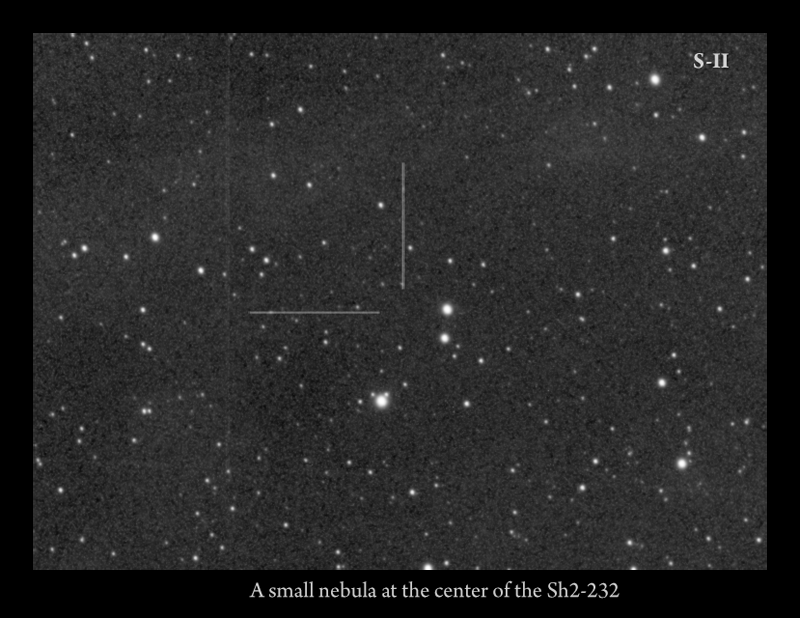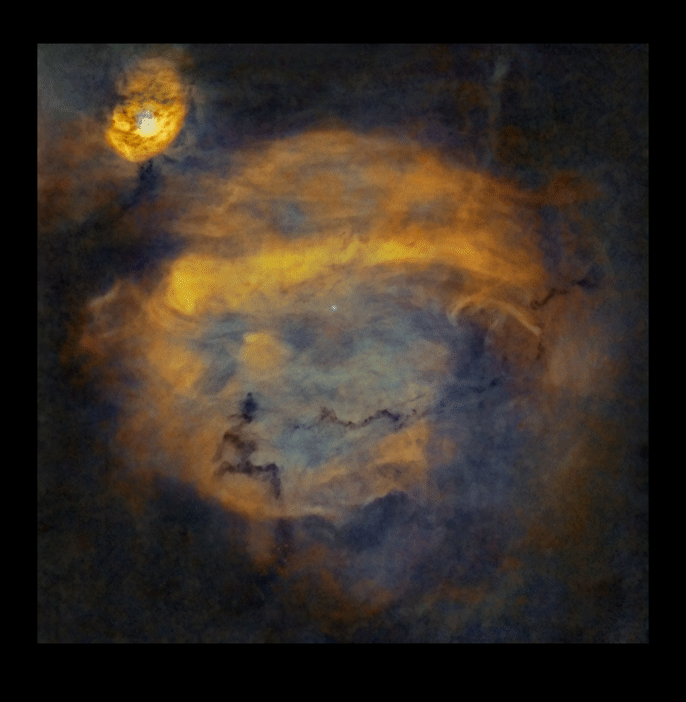COPYRIGHT, PLEASE NOTE
All the material on this website is copyrighted to J-P Metsavainio, if not otherwise stated. Any content on this website may not be reproduced without the author’s permission.
Have a visit in my portfolio
PORTFOLIO:https://astroanarchy.zenfolio.com/
Friday, April 3, 2015
NGC 1491
I shot the data for this dim object at 16. March but the processing of it ready now. I found this as a difficult target due to a very low surface brightness of the surrounding nebula. The central part is bright and it makes difficult to balance image nicely.
Click for a large image
Natural color composition from the emission of ionized elements, R=80%Hydrogen+20%Sulfur, G=100%Oxygen and B=85%Oxygen+15%Hydrogen to compensate otherwise missing H-beta emission. This composition is very close to a visual spectrum.
Click for a large image
INFO
NGC 1491 is an emission nebula at the constellation Perseus. The distance from the Earth is about 11.000 light years. In the bright area, at a center of the photo, a strong stellar wind from a star BD +50 ° 886 is blowing the gas away. The radiation from the same star makes the gas glow by ionizing elements in the nebula.
Image in mapped colors
Click for a large imageImage is in mapped colors from an emission of the ionized elements. Golden areas are from emission of sulfur and hydrogen, S-II and H-alpha, blueish areas are from ionized oxygen, O-III.
A wider field version in mapped colors
Click for a large image
Image in light of an ionized hydrogen, H-alpha, only
This B&W photo show the emission of H-alpha only
Orientation in an older wide field photo of the area
An area of the new photo is marked as a white rectangle. The wide field photo is taken at February 5, 2012 with a Canon EF 200mm f1.8 camera lens, QHY9 camera and narrowband filters. More info about this picture can be seen HERE.
Technical details
Processing work flow
Image acquisition, MaxiDL v5.07.
Stacked and calibrated in CCDStack2.
Deconvolution with a CCDStack2 Positive Constraint, 33 iterations, added at 50% weight
Color combine in PS CS3
Levels and curves in PS CS3.
Imaging optics
Celestron Edge HD 1100 @ f7 with 0,7 focal reducer for Edge HD 1100 telescope
Mount
10-micron 1000
Cameras and filters
Imaging camera Apogee Alta U16 and Apogee seven slot filter wheel
Guider camera, Lodestar x2 and SXV-AOL
Astrodon filter, 5nm H-alpha
Astrodon filter, 3nm O-III
Astrodon filter, 3nm S-II
Exposure times
H-alpha, 15 x 1200s = 5h
O-III, 6 x 1200s binned 4x4 = 2h min.
S-II, 6 x 1200s binned 4x4 = 2h min.
Total 9h
A single un cropped, calibrated and stretched 20 min. H-alpha frame as it comes from the camera
Click for a large image
Not much can be seen in this single 20min. exposure of the emission of hydrogen, H-alpha.
Labels:
Narrowband color images,
nebula
Tuesday, March 31, 2015
IC 1795 in the Heart Nebula
I spent hours in two nights by shooting this busy area in IC 1805, the Heart nebula, at 13. and 15. March.
IC 1795
Click for a large image
Image is in mapped colors from an emission of the ionized elements. Golden areas are from emission of sulfur and hydrogen, S-II and H-alpha, blueish areas are from ionized oxygen, O-III.
A closeup
Click for a large image
INFO
IC 1795 is also known as a Fish Head Nebula. It's a star forming region in the northern constellation Cassiopeia at distance of about 6000 light years. My image shows about a square degree of sky, the actual size of the imaged area is around 130 light years. IC 1795 is a part of the large nebula complex known as IC 1805, the Heart Nebula.
Image in visual spectrum
Click for a large image
Natural color composition from the emission of ionized elements, R=80%Hydrogen+20%Sulfur, G=100%Oxygen and B=85%Oxygen+15%Hydrogen to compensate otherwise missing H-beta emission. This composition is very close to a visual spectrum.
Image in emission of an ionized hydrogen only (H-alpha)
A two frame mosaic
Click for a large image
This photo of IC 1805 was partly overlapping with my previous image from the same area.
I made a small two frame mosaic out of them. I have shot more frames after this imaging project and now I'm able to make a high resolution mosaic of the whole IC 1805 area. I'll publish that later.
This two frame mosaic is in mapped colors. I have material for the whole IC 1805 area but I'll publish it later. Blog post about the Melotte 15 at the left part of the mosaic above can be seen HERE.
Orientation in IC 1805, the Heart Nebula
Click for a large image
The area of IC 1795 is marked as a white rectangle.
Technical details
Processing work flow
Image acquisition, MaxiDL v5.07.
Stacked and calibrated in CCDStack2.
Deconvolution with a CCDStack2 Positive Constraint, 33 iterations, added at 50% weight
Color combine in PS CS3
Levels and curves in PS CS3.
Imaging optics
Celestron Edge HD 1100 @ f7 with 0,7 focal reducer for Edge HD 1100 telescope
Mount
10-micron 1000
Mount
10-micron 1000
Cameras and filters
Imaging camera Apogee Alta U16 and Apogee seven slot filter wheel
Guider camera, Lodestar x2 and SXV-AOL
Astrodon filter, 5nm H-alpha
Astrodon filter, 3nm O-III
Astrodon filter, 3nm S-II
Exposure times
H-alpha, 15 x 1200s = 5h
O-III, 3 x 1200s = 1h min.
S-II, 3 x 1200s = 1h min.
Total 7h
A single un cropped, calibrated and stretched 20 min. H-alpha frame as it comes from the camera
Labels:
Narrowband color images,
nebula
Optikfestival in Skara, Sweden
I had a pleasure to be invited as one of the speakers in "Optikfestival Skara", Sweden. The happening was organized by a Astrosweden, a largest optics retailer in Sweden. They are specialized to Astronomy, nature photography, hunting and microscopy. I was really impressed by the passion and knowledge they have about the the optics!
The owner, Christer Kjellner, has a personal interest to the subject and the sales team are experienced users of the products they are selling. That's not too common now a days! No matter if you are just entering in the subject or professional user they will find a solution for you, I'm sure.
I can highly recommend Astrosweden, if you'll have any needs for Astronomy, nature photographing, hunting scopes or microscopy.
Ask for an offer or just have a look to the webshop: http://www.astrosweden.se/
Interior of the shop, they have a large stock of products on site.
Duel of the nature photographers
Tuesday, March 24, 2015
The blue dot and rings in Sh2-232
This is a followup to my previous blog post. When I was processing the data, I noticed a small nebula in center of the large complex of Sharpless 232. It seems to be the only O-III emission source in this large emission nebula. My O-III exposure was relatively short though, only 2h. The origin of this small ionization zone puzzles me. I made a small animation from integrated emission channels. No other processing, than calibration and simple un linear stretching has been done to the images.
EDIT
One mystery solved with a help from another astroguy. "Saloja" from a Finnish astro group used the Megastar database and found out, that this blue dot is a known planetary nebula, PN G173.5+03.2. Thank you Saloja!
Narrowband image of Sh2-232 in mapped colors
Note the blue dot at middle of the photo, it's not a star but a small area of nebula emitting the O-III light.
This animated GIF shows all three emission channels imaged for this photo, O-III, S-II and H-alpha.
The small nebula is visible in both, H-a and O-III, S-II doesn't show it. It could be nice to understand the mechanism behind this small object.
Is it part of the large nebula and what is the energy source for the ionization? It might even be a planetary nebula, part of the large Sh2-232 complex or a separate object front or behind it.
Has anyone else noticed this object? Let me know, if you have some info about it.
Is it part of the large nebula and what is the energy source for the ionization? It might even be a planetary nebula, part of the large Sh2-232 complex or a separate object front or behind it.
Has anyone else noticed this object? Let me know, if you have some info about it.
Another interesting feature of Sh2-232
A ring like formation
I have animated to this starless version of Sh2-232 photo, what I'm seeing in lower part of the nebula. There is a ring like formation and I'm seeing some hints of the concentric structure too.
Subscribe to:
Posts (Atom)
















%2Bcopy.jpg)













